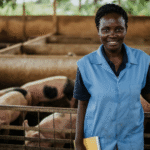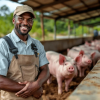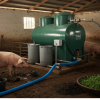Complete Guide to Pork Marketing in Uganda: Finding Buyers and Maximizing Profits
Uganda’s pork market offers tremendous opportunities for farmers who understand how to access buyers and negotiate favorable prices. However, many pig farmers struggle with marketing their products effectively, often accepting low prices or facing difficulties finding reliable buyers. HOG4Education’s market access program has connected over 200 farmers to profitable markets, achieving average price premiums of 15-25% above local market rates while ensuring consistent sales throughout the year.
Understanding Uganda’s Evolving Pork Market
Uganda’s pork consumption has grown dramatically over the past decade, creating unprecedented opportunities for pig farmers who can access these expanding markets effectively. Urban consumption leads this growth, with Kampala, Jinja, Mbale, and other cities showing consistent demand increases.
Market Size and Growth Trends:
- National pork consumption: 2.8kg per person annually (2024)
- Urban consumption rates: 4.5kg per person annually in major cities
- Market growth rate: 8-12% annually over the past five years
- Total market value: Estimated 450 billion UGX annually
- Supply gap: Domestic production meets only 75% of demand
Consumer Preference Changes: Modern Ugandan consumers increasingly prefer fresh, high-quality pork from known sources rather than processed or imported alternatives. This trend creates opportunities for farmers who can provide consistent quality and build buyer relationships.
Regional Market Variations:
- Central Uganda: Highest consumption rates, premium prices, quality-focused buyers
- Eastern Uganda: Growing market with improving transportation infrastructure
- Northern Uganda: Emerging market with significant growth potential
- Western Uganda: Established market with cultural acceptance and steady demand
Understanding these market dynamics enables farmers to position their products effectively and target the most profitable market segments.
Identifying and Accessing Target Customer Segments
Successful pork marketing requires understanding different customer segments and their specific needs, preferences, and purchasing patterns.
Direct Consumer Sales:
Urban Households: Increasingly purchasing fresh pork directly from farmers, seeking quality assurance and competitive prices. Average purchase: 2-5kg per transaction, willing to pay premiums for quality.
Rural Households: Traditional customers purchasing for special occasions and celebrations. Price-sensitive but value relationships with trusted suppliers.
Market Advantages: Higher profit margins, direct customer feedback, relationship building opportunities, payment on delivery.
Challenges: Small transaction sizes, transportation requirements, time-intensive customer service.
Restaurant and Hotel Sector:
Urban Restaurants: Consistent buyers requiring regular supply of specific cuts and quality standards. Average purchase: 15-30kg weekly per establishment.
Hotels and Lodges: Large-volume buyers with predictable ordering patterns and quality requirements. Focus on presentation and consistent sizing.
Catering Services: Bulk buyers for events and institutional catering with seasonal demand variations.
Market Advantages: Large volume sales, predictable ordering patterns, long-term relationships, premium prices for consistent quality.
Challenges: Strict quality requirements, payment terms negotiation, delivery scheduling demands.
Wholesale and Retail Markets:
Wholesale Traders: Buy large quantities for distribution to retailers throughout the region. Volume-focused with emphasis on competitive pricing.
Retail Butcheries: Local shops requiring regular supply of various cuts and sizes. Balance between price and quality considerations.
Supermarket Chains: Growing segment requiring formal documentation, consistent supply, and specific packaging standards.
Market Advantages: Large transaction volumes, established distribution networks, reduced marketing effort.
Challenges: Lower profit margins, credit terms, competition from other suppliers.
Processing and Value-Added Markets:
Sausage Manufacturers: Specialized buyers requiring specific pig weights and quality characteristics for processing.
Bacon Producers: Focus on particular pig breeds and feeding programs to achieve desired meat characteristics.
Traditional Processing: Local producers of traditional pork products for cultural celebrations and ceremonies.
Market Advantages: Premium prices for specialized requirements, long-term supply agreements, value-added opportunities.
Challenges: Specific quality requirements, limited number of buyers, technical specifications.
Success Story: Margaret Achan’s Market Development Journey
Margaret Achan’s transformation from struggling local seller to successful market entrepreneur demonstrates the power of strategic market development and buyer relationship building.
Initial Marketing Challenges (2023):
- Selling only to immediate neighbors at low prices
- Irregular sales creating cash flow problems
- No understanding of market demand or pricing
- Limited transportation affecting market access
- Average selling price: 6,500 UGX per kg live weight
Joining HOG4Education’s Market Access Program: In early 2024, Margaret enrolled in HOG4Education’s comprehensive market access training, learning to identify buyers, negotiate prices, and build sustainable customer relationships.
Market Analysis and Customer Identification: Margaret learned to analyze her local market and identify potential customers beyond her immediate community:
Market Research Results:
- Identified 8 restaurants within 15km requiring regular pork supply
- Located 3 wholesale buyers serving regional markets
- Found 12 retail butcheries seeking reliable suppliers
- Discovered seasonal demand patterns and pricing trends
Relationship Building Strategy: Rather than trying to serve all markets immediately, Margaret focused on building strong relationships with 3 key customers representing different market segments.
Customer 1: Safari Restaurant (Urban Restaurant)
- Weekly requirement: 25kg dressed pork
- Quality focus: Consistent sizing, cleanliness, freshness
- Price achieved: 9,200 UGX per kg dressed weight
- Payment terms: Cash on delivery
- Relationship building: Regular communication, quality consistency, reliable delivery
Customer 2: Kumi Wholesale Market (Wholesale Trader)
- Monthly requirement: 8-10 live pigs
- Focus: Competitive pricing, healthy animals, consistent supply
- Price achieved: 8,100 UGX per kg live weight
- Payment terms: 50% deposit, balance on delivery
- Relationship benefits: Bulk sales, reduced marketing effort
Customer 3: Community Butchery Network (Retail)
- Weekly requirement: 15kg various cuts
- Focus: Competitive pricing, community relationships
- Price achieved: 8,800 UGX per kg dressed weight
- Payment terms: Weekly payment cycle
- Benefits: Consistent local demand, community reputation building
Implementation and Results:
First Quarter 2024:
- Achieved average selling price: 8,400 UGX per kg (29% increase)
- Established regular delivery schedule to 3 key customers
- Reduced time spent on marketing by 60%
- Improved cash flow predictability
Second Quarter 2024:
- Expanded customer base to 6 buyers across different segments
- Developed reputation for quality and reliability
- Achieved average selling price: 8,800 UGX per kg (35% increase from original)
- Began planning production increases to meet demand
Current Status (December 2024):
- Serves 10 regular customers across multiple market segments
- Average selling price: 9,100 UGX per kg (40% above original prices)
- Operates with 95% of production pre-sold before slaughter
- Monthly gross income increased 165% through market development
“HOG4Education didn’t just teach me pig farming,” Margaret explains. “They showed me how to build a business by understanding my customers and giving them what they want. Now buyers contact me instead of me searching for buyers.”
Margaret now mentors other farmers in market development and serves as a regional coordinator for HOG4Education’s buyer network.
Quality Standards and Customer Expectations
Meeting and exceeding customer quality expectations is essential for building profitable, long-term market relationships. Different market segments have varying quality requirements that farmers must understand and meet consistently.
Health and Safety Standards:
Animal Health Documentation: Veterinary certificates, vaccination records, and health monitoring documentation increasingly required by quality-conscious buyers.
Meat Safety Practices: Proper slaughter techniques, hygiene during processing, and temperature control during transportation and storage.
Traceability Requirements: Ability to track animals from farm to consumer, including feed sources, health treatments, and production practices.
Legal Compliance: Meeting local government health regulations and obtaining necessary permits for meat sales and transportation.
Physical Quality Indicators:
Live Animal Quality:
- Healthy appearance, good body condition, appropriate weight
- Clean animals free from external parasites or skin conditions
- Good muscling and fat distribution indicating proper nutrition
- Calm temperament suggesting good handling and low stress
Meat Quality Characteristics:
- Proper color (pale pink to red) indicating good health and handling
- Firm texture without excessive moisture or soft areas
- Minimal fat thickness appropriate for customer preferences
- Good marbling and meat-to-bone ratios
Presentation and Packaging Standards:
Professional Presentation: Clean packaging, proper labeling, and attractive presentation that reflects quality and care.
Appropriate Sizing: Consistent sizing meeting customer specifications and convenience requirements.
Temperature Control: Proper cooling and temperature maintenance during transportation and delivery.
Customer Service Excellence: Reliable delivery, responsive communication, and professional interactions.
Pricing Strategies for Maximum Profitability
Effective pricing requires understanding market conditions, customer segments, and value proposition while maximizing profitability and maintaining competitive positioning.
Market Price Analysis:
Current Uganda Market Prices (December 2024):
- Live weight prices: 7,000-9,500 UGX per kg depending on quality and location
- Dressed weight prices: 9,500-12,000 UGX per kg for wholesale
- Retail prices: 12,000-15,000 UGX per kg in urban markets
- Premium markets: 15,000-18,000 UGX per kg for specialty products
Factors Affecting Pricing:
- Animal quality and health status
- Customer relationship and reliability
- Market location and transportation costs
- Seasonal demand variations
- Competition from other suppliers
- Payment terms and credit arrangements
Value-Based Pricing Strategies:
Quality Premiums: Charging higher prices for superior quality, health documentation, and consistent supply reliability.
Service Differentiation: Premium pricing for additional services like delivery, custom cutting, or flexible scheduling.
Relationship Value: Long-term customers often willing to pay premiums for trusted suppliers who meet their specific needs consistently.
Market Positioning: Positioning as premium supplier based on farming practices, animal welfare, and customer service.
Negotiation Techniques:
Preparation: Understanding market prices, customer needs, and your own cost structure before entering price negotiations.
Value Demonstration: Showing customers the specific benefits and quality advantages of your products compared to alternatives.
Flexible Options: Offering different pricing structures based on volume, payment terms, or service levels.
Relationship Focus: Emphasizing long-term partnership rather than individual transaction pricing.
HOG4Education’s Integrated Market Network
HOG4Education has developed a comprehensive market network that guarantees market access for participating farmers while achieving premium prices through quality assurance and relationship management.
Guaranteed Buyer Network:
Restaurant and Hotel Partners: 15 established restaurants and hotels across Eastern Uganda with regular purchasing agreements.
Wholesale Distribution: 8 wholesale buyers serving regional markets with capacity for increased supply.
Processing Partnerships: 4 value-added processors requiring consistent supply of specific pig types.
Export Opportunities: Emerging opportunities for cross-border sales to Kenya and South Sudan markets.
Quality Assurance Program:
Farm Certification: Verification of farming practices, animal health, and production standards.
Supply Chain Monitoring: Tracking and documentation throughout the supply chain from farm to customer.
Customer Feedback System: Regular communication with buyers to ensure satisfaction and identify improvement opportunities.
Price Benchmarking: Market price monitoring and negotiation support to ensure farmers receive fair prices.
Benefits for Participating Farmers:
- Guaranteed market access for all production
- Premium pricing 15-25% above local market rates
- Reduced marketing time and effort
- Professional buyer relationship management
- Quality improvement support and training
- Payment security and dispute resolution
Network Expansion and Development:
- Adding 10 new buyer relationships quarterly
- Expanding into new geographic markets
- Developing value-added product opportunities
- Creating farmer leadership and coordination roles
Building Long-Term Customer Relationships
Sustainable pork marketing success depends on developing strong, long-term relationships with buyers rather than focusing solely on individual transactions.
Relationship Building Strategies:
Consistent Quality Delivery: Meeting or exceeding customer expectations consistently over time builds trust and loyalty that translates into premium pricing and preferential treatment.
Communication Excellence: Regular communication about availability, scheduling, and any potential issues demonstrates professionalism and reliability.
Customer Service Orientation: Going beyond basic product delivery to solve customer problems and meet specific needs creates competitive advantages.
Reliability and Dependability: Consistent delivery schedules, accurate order fulfillment, and professional handling build reputation and customer confidence.
Value-Added Services:
Custom Processing: Offering specific cuts, sizing, or preparation services that meet individual customer requirements.
Flexible Scheduling: Accommodating customer timing needs and seasonal variations in demand.
Quality Documentation: Providing health certificates, production records, and traceability documentation that customers value.
Market Intelligence: Sharing market information and trends that help customers make better purchasing decisions.
Customer Retention Strategies:
Loyalty Programs: Offering preferential pricing, terms, or services to long-term customers who provide consistent business.
Exclusive Arrangements: Developing exclusive supply agreements that benefit both farmers and buyers through guaranteed volumes and pricing.
Joint Problem Solving: Working with customers to address challenges and develop solutions that benefit both parties.
Continuous Improvement: Regularly seeking feedback and implementing improvements based on customer needs and market changes.
Overcoming Common Marketing Challenges
Pig farmers face predictable marketing challenges that can be addressed through proper planning, skill development, and strategic approaches.
Transportation and Logistics:
Challenge: Limited transportation options and high costs for moving pigs to distant markets.
Solutions: Cooperative transportation arrangements, buyer pickup services, strategic location selection for production facilities.
Payment Terms and Credit:
Challenge: Buyers requesting credit terms while farmers need immediate cash flow for operations.
Solutions: Graduated payment systems, deposit requirements, working capital management, alternative financing options.
Seasonal Demand Fluctuations:
Challenge: Varying demand throughout the year affecting prices and sales opportunities.
Solutions: Production planning aligned with demand cycles, customer diversification, value-added processing options.
Competition and Market Saturation:
Challenge: Increasing competition from other farmers and commercial producers.
Solutions: Quality differentiation, customer service excellence, niche market development, value-added products.
Quality Control and Consistency:
Challenge: Maintaining consistent quality standards across all production and sales.
Solutions: Standardized production practices, quality monitoring systems, customer feedback integration.
Expanding Market Reach and Opportunities
As farmers gain experience and build successful operations, opportunities exist for expanding market reach and developing new revenue streams.
Geographic Expansion:
Regional Markets: Expanding sales beyond local areas to serve regional markets with higher prices and larger volumes.
Urban Market Development: Targeting urban consumers willing to pay premiums for quality and local sourcing.
Cross-Border Opportunities: Exploring export opportunities to neighboring countries with developing markets.
Value-Added Product Development:
Processed Products: Developing sausages, bacon, and traditional products that command premium prices.
Direct-to-Consumer Sales: Farmers markets, online sales, and direct delivery services.
Agritourism Integration: Farm tours, educational programs, and direct sales to visitors.
Wholesale and Distribution:
Cooperative Marketing: Working with other farmers to achieve scale for wholesale opportunities.
Distribution Partnerships: Developing relationships with distributors serving multiple market segments.
Private Label Opportunities: Supplying products for retailers or restaurants under their own branding.
Technology and Innovation in Pork Marketing
Modern technology offers new opportunities for improving marketing efficiency and reaching customers more effectively.
Digital Marketing Tools:
Mobile Communication: Using mobile phones for customer communication, order taking, and payment coordination.
Social Media Marketing: Leveraging Facebook, WhatsApp, and other platforms for customer outreach and relationship building.
Online Marketplaces: Participating in digital agricultural marketplaces and e-commerce platforms.
Digital Payment Systems: Mobile money and digital payment options for customer convenience and transaction security.
Supply Chain Technology:
Inventory Management: Simple systems for tracking production, inventory, and sales.
Customer Relationship Management: Basic systems for managing customer information and communication.
Logistics Coordination: Technology tools for coordinating transportation and delivery.
Quality Tracking: Digital tools for recording and sharing quality information with customers.
Getting Started with Strategic Pork Marketing
Farmers ready to improve their marketing effectiveness and profitability can begin immediately with HOG4Education’s proven market access program.
Market Assessment and Planning:
- Analysis of local and regional market opportunities
- Customer identification and segmentation
- Competitive analysis and positioning strategy
- Revenue projections and business planning
Customer Development and Relationship Building:
- Buyer identification and initial contact strategies
- Relationship building techniques and customer service training
- Negotiation skills and pricing strategy development
- Contract development and management
Quality and Service Excellence:
- Quality standard development and implementation
- Customer service training and communication skills
- Problem-solving and customer retention strategies
- Continuous improvement and feedback integration
Marketing Support and Network Access:
- Connection to HOG4Education’s established buyer network
- Ongoing marketing support and business development
- Peer learning networks and farmer group participation
- Advanced marketing techniques and market expansion
Contact HOG4Education at +256787498143 or visit our market development center in Kumi Municipality to learn strategic pork marketing techniques. Transform your pig farming operation from production-focused to market-driven success.
Build sustainable customer relationships, achieve premium pricing, and create predictable income through HOG4Education’s proven market access program. Your profitable pork marketing success starts with strategic customer development.
Learn more about our comprehensive pig farming support programs and marketing success stories in our other blog posts. Follow HOG4Education for regular updates on market trends and profitable farming strategies.








4 Comments
Anna Brown
Thanks for sharing this information is useful for us.
cmsmasters
Always happy to be of service.
Mia Queen
This is awesome!!!
cmsmasters
Thanks.